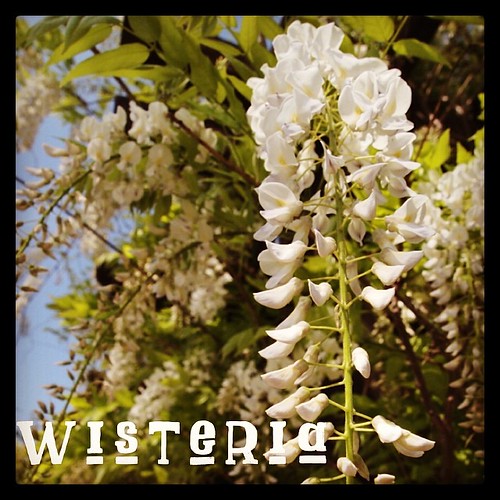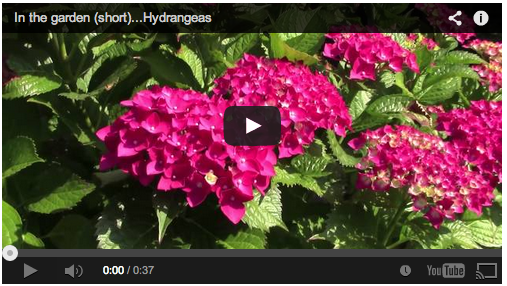Garden Alphabet: Wistera
The epitome of Spring, the big, burly, grasping, sprawling and blowzy wisteria is a favorite in many gardens. You need a hefty trellis or pergola to host this (potential) monster of a plant. For that, you will be rewarded with an explosion of draping purple or white flowers that attract hummingbirds and bees and are an impressive indicator that Spring has finally arrived. Wisteria can be a bit fussy about blooming. It wants just enough light, water and nutrients. Too little (or too much) can turn it into a mass of green foliage but produce few flowers. Typically you want to prune Wisteria twice a year — once during its dormant period and again mid-season to keep its growth in control. For me, this means pulling its tenacious tendrils off of every surround plant and roof surface and tying it back onto the pergola where it belongs.
Wisteria
Wisteria (also spelled Wistaria or Wysteria) is a genus of flowering plants in the pea family, Fabaceae, that includes ten species of woody climbing vines native to the Eastern United States and to China, Korea, and Japan. Some species are popular ornamental plants, especially in China and Japan. An aquatic flowering plant with the common name wisteria or ‘water wisteria’ is in fact Hygrophila difformis, in the family Acanthaceae.
The botanist Thomas Nuttall said he named the genus Wisteria in memory of Dr. Caspar Wistar (1761–1818).[1][2] Questioned about the spelling later, Nuttall said it was for “euphony,” but his biographer speculated that it may have something to do with Nuttall’s friend Charles Jones Wister, Sr., of Grumblethorpe, the grandson of the merchant John Wister.[3] (Some Philadelphia sources state that the plant is named after Wister.)[4] As the spelling is apparently deliberate, there is no justification for changing the genus name under the International Code of Botanical Nomenclature.[5] However, some spell the plant’s common name “wistaria”.[6][7]
Genetic analysis shows Callerya and Wisteria to be each other’s closest relatives and quite distinct from other members of the tribe Millettieae. Both have eight chromosomes.[8] — Wikipedia
More information on Wistera:
- Acanthus
- Amaryllis
- Apricot (Prunus armeniaca)
- Azalea
- Banana
- Bonsai
- Bougainvillea
- Brugmansia
- Butterfly (Lepidoptera)
- California Poppy (Eschscholzia californica)
- Calla Lily (Zantedeschia aethiopica)
- Castor Bean (Ricinus)
- Caltapa
- Chives (Allium schoenoprasum)
- Clematis
- Camellia
- Currant (Ribes)
- Dahlia
- Datura
- Japanese Cherry (Prunus serrulata)
- Daffodil (Narcissus)
- Dietes (Fortnight Lily)
- Dudleya
- Echinacea
- Ecualyptus
- Freesia
- Fungi
- Grape (Vitis vinifera)
- Hibiscus (Malvaceae)
- Iris
- Joshua Tree (Yucca brevifolia)
- Kniphofia “Red Hot Poker”
- Lantana
- Lavender (Lavendula)
- Kousa Dogwood (Cornus kousa)
- Magnolia x soulangeana (Saucer Magnolia/Tulip Tree)
- Marigold (Calendula officinalis)
- Matilija Poppy (Romneya)
- Morning Glory (Convolvulaceae)
- Nandina
- Orange
- Orchid from the Southern California Spring Garden Show 2013
- Oriental Poppy (Papaver orientale)
- Polygonatum (Solomon’s Seal)
- Paperwhites
- Pineapple (Ananas comosus)
- Primula (Primrose)
- Queen Anne’s Lace (Daucus carota)
- Rudbeckia
- Salvia
- Squirrel
- Succulents
- Sweet Potato (Ipomoea batatas)
- Tomato
- Water Lily (Nymphaeaceae)
<a href=”http://www.amazon.com/gp/product/006039207X/ref=as_li_ss_il?ie=UTF8&camp=1789&creative=390957&creativeASIN=006039207X&linkCode=as2&tag=thewelchwritecom”><img border=”0″ src=”http://ws-na.amazon-adsystem.com/widgets/q?_encoding=UTF8&ASIN=006039207X&Format=_SL250_&ID=AsinImage&MarketPlace=US&ServiceVersion=20070822&WS=1&tag=thewelchwritecom” ></a><img src=”http://ir-na.amazon-adsystem.com/e/ir?t=thewelchwritecom&l=as2&o=1&a=006039207X” width=”1″ height=”1″ border=”0″ alt=”” style=”border:none !important; margin:0px !important;” />





